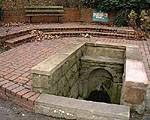Rainwater Harvesting
What's RWH ?
Water harvesting is the process of intercepting stormwater runoff from a surface (e.g. roof, parking area, land surface), and putting it to beneficial use. Intercepted stormwater can be collected, slowed down, and retained or routed through the site landscape using microbasins, swales and other water harvesting structures. Water harvesting reduces dependence on dwindling groundwater reserves and expensive Dam projects for water. Capturing and using stormwater runoff also reduces site discharge and erosion, and the potential transport of stormwater pollutants.
Urban sites typically have a high ratio of impervious area (buildings and pavement) to pervious area (vegetated and bare soil areas). By harvesting and using stormwater you can:
• Increase water availability for on-site vegetation,
• Reduce on-site flooding and erosion,
• Reduce water bills and groundwater pumping, and
• Extend the life of landscaping (rainwater is usually low in salt content
and relatively high in nitrogen).
The site is key to reducing costs and maximizing long-term benefits.
Areas where the total rainfall occurs only during 3 or 4 months of monsoon, Rainwater collected throughout the monsoon has to be stored throughout the year, which means that huge volumes of storage containers would be required. So, it is always feasible in these areas to use rainwater to recharge groundwater aquifers rather than for storage.
In a Nut shell
Water Harvesting Techniques
Goals for Technique | Approximate Locations | Variation | ||||||
Micro basins |
| |||||||
Captures surface water from very small catchment areas and infiltrates it into the soil.
| Gentle to nearly flat sloped land. Very small to small catchment areas (10s to 100s of m2)
|
| ||||||
Swales on contour |
|
| ||||||
Captures surface water from small to moderate catchment areas and infiltrates it into the soil
| Small to moderate sized catchment areas with gentle slopes. Large scale use should be based on engineered designs.
|
| ||||||
Swales off contour |
|
| ||||||
Captures surface water from small to moderate catchment areas and slowly conveys it down gradient while it infiltrates into the soil.
| Small to moderate sized catchment areas with gentle slopes. Large scale use should be based on engineered designs.
|
| ||||||
French Drains |
|
| ||||||
Captures surface water and rapidly conveys it underground in a subsurface trench. Maximize the infiltration while minimizing evaporation.
| Very small to small catchment areas. Flat to moderate sloped land. Avoid use in areas where sediment will clog pores in the French drain.
|
| ||||||
Gabions |
|
| ||||||
Slows surface water flow in very small drainages, capture detritus and sediment from water to fill in erosion cuts upstream of the gabion.
| Very small drainages with stable banks. Put in straight reaches of the drainage, not on curves.
|
| ||||||
Water tanks/cisterns |
|
| ||||||
Stores harvested water for later use.
| Above-ground tanks placed high in the landscape afford more head for gravity feed. Water stored in both above- and below ground tanks can be accessed via small pumps |
| ||||||
Mulch |
|
| ||||||
Aids water infiltration into soils, retards evaporation. Enriches soil nutrients, suppresses weed growth, helps to reduce pollutants. Keeps soil temperature lower in summer and warmer in winter. | Basins, swales and other water harvesting depressions. Place mulch 3 - 4 inches deep. Replenish as needed.
|
| ||||||
